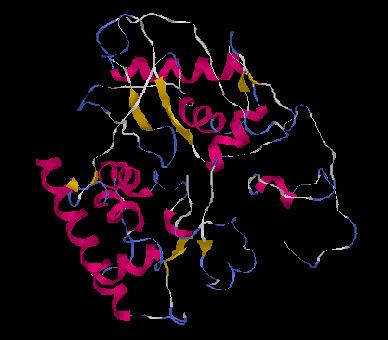 | ||
TMEM156 is a gene that encodes the transmembrane protein 156 (TMEM156) in Homo sapiens. It has the clone name of FLJ23235.
Contents
Locus
TMEM156 is located on the short arm of Chromosome 4. It is found at position 4p14. It has four known transcripts, only two of which have proteins.
Gene neighborhood
Cytogenetic band: 4p14
The image above shows chromosome four and the various gene locations on it. TMEM156 can be seen at the thin red band that has been placed at p14.
Size
TMEM156 is 66,499 bases and 296 amino acids in length. TMEM156 spans from 38,966,744 to 39,032,922 bp.
Splice Variants
TMEM156 has one known splice variant, TMEM156-003. It has one transmembrane region and is 179 amino acids in length resulting in a lower molecular mass of 20.9 kDa. In addition the isoelectric point is 7.0633 and the gene has four transcripts.
Isoforms
There is one known isoform of TMEM156. This particular isoform uses an alternate in-frame splice site in the 3' coding region. The resulting isoform is shorter than the original.
Primary structure
The TMEM156 protein is 296 amino acids in length. It has a molecular weight of 34.323 kDa and an isoelectric point of 7.98. The protein interacts with the membrane three total times as seen in the figure below.
Secondary Structure
TMEM156 has a secondary structure composed of primarily α-helices. Phyre was used to create this structure that can be viewed on the right hand side of this article. It is evident that the predicted protein structure is vastly composed of α-helices. The N terminus is located at the top of the image and the C terminus is at the bottom.
Tertiary Structure
This structure was predicted by analyzing the amino acid sequence using I-TASSER. The final result can be see below.
Post-Translational Modifications
Glycosylation at Asn 45 and Asn 156 along with N-glycosylation seen in the portion of the protein that is found in the cytoplasm.
Subcellular Location
The k-NN tool suggests the location of TMEM156 in the Endoplasmic Reticulum of the cell with 44.4% certainty. The following locations were all predicted with 11.1% certainty: vacuolar, vesicles of secretory system, extracellular, plasma membrane, and mitochondrial.
Expression
TMEM156 is expressed in several tissues including ascites, bone marrow, salivary glands, and vascular to name a few. It should be noted this gene is not ubiquitously expressed, but is still evident in many tissues. This gene is predominately expressed in adults but there is a bit of expression in fetuses.
Interacting Proteins
Homology
Transmembrane protein 156 has one known paralog. It also has various orthologs within eukaryotes. The table below compares an overarching sample of the known orthologs and one paralog. The specific lineage of TMEM156 is: Eukaryota; Metazoa; Chordata; Craniata; Vertebrata; Euteleostomi; Mammalia; Eutheria; Euarchontoglires; Primates; Haplorrhini; Catarrhini; Homindae; Homo.
Clinical Significance
TMEM156 has been noted in various research papers. The most extensive research that has been published to date describes the potential involvement of TMEM156 in breast, liver and prostate cancer. There is a potential for this gene to encode for how invasive these cancers are.
